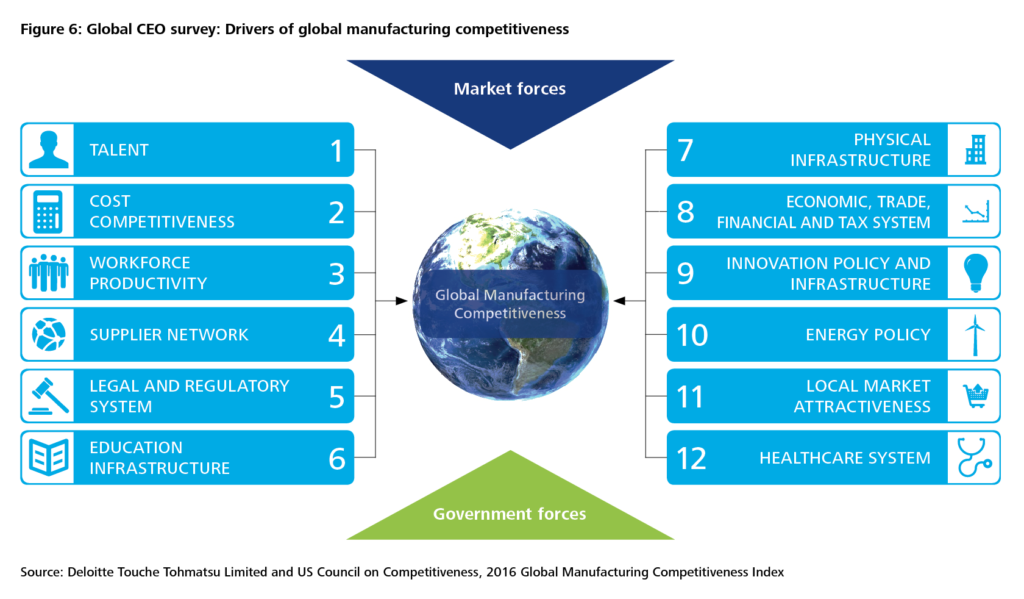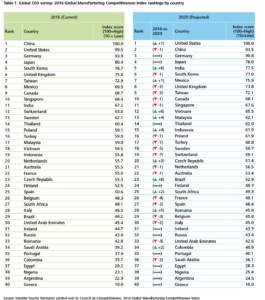Inside Supply Management Magazine
U.S. Poised to be Most CompetitiveManufacturing Nation

In recent years, China has ranked as the world’s most competitive manufacturing nation. But by 2020, it will likely fall to No. 2, relinquishing the No. 1 spot to the United States, according to the 2016 Global Manufacturing Competitiveness Index report by Deloitte Touche Tohmatsu Limited (Deloitte Global) and the Council on Competitiveness.
Michelle Drew Rodriguez, manufacturing leader, Center for Industry Insights at Deloitte, says that two factors — talent and advanced technology — are the drivers “that can propel the U.S. to the No. 1 position going forward."
She and Craig Giffi, U.S. automotive leader at Deloitte Services LP, authored the report, which surveyed more than 500 senior manufacturing executives from around the world. The report, conducted twice before (2010 and 2013), is designed to help global industry executives and policy-makers evaluate drivers that are key to company- and country-level competitiveness and identify nations expected to offer the most competitive manufacturing environments through the end of the decade.
Although the U.S. is the leader in emphasizing talent and advanced technology, a few other countries, such as Japan, are adopting similar strategies, the report states.
Manufacturing’s Shifting Focus
"CEOs and executives around the world are really starting to shift to higher-value advanced manufacturing,” Drew Rodriguez says. "Despite it being a global economy — and given that manufacturing is moving up the technology curve and adopting technologies that are innovative at exponential rates— executives are recognizing that it's no longer about where to go to make products the cheapest way possible.” Instead, they are focusing on where new innovations are occurring and where the talent resides, she says. Innovation and manufacturing competitiveness are closely tied as well, the report states.
Still, cost competitiveness is among the major factors driving global manufacturing competitiveness. According to the report, others are talent, workplace productivity and supplier networks.
Talent: A Major Driver
"Talent has been the No. 1 driver and continues to be the key differentiator as manufacturers are looking to become employers of choice,” Drew Rodriguez says. But all four of the top drivers are synergistic in nature and help manufacturers develop new models of collaboration, she says.
“Talent is first and foremost, but when you couple in cost competitiveness and workforce productivity, it tells an interesting story. Then adding supplier networks, which are becoming increasingly important ... it becomes an ecosystem approach rather than the traditional vertically integrated methods that have been used in the past,” Drew Rodriguez says.
“It's no longer just the talent inside your given walls, but also it's the broader ecosystem, and ensuring the most productive and efficient ways to bringing innovative products and services to market.”
A Look at Regions
Other findings of the survey are:
●Emergence of the “MITI V” or Mighty Five: Malaysia, India, Thailand, Indonesia and Vietnam. "Those five are really rising up the ranks, especially as you look at current to future competitiveness,” Drew Rodriguez says. “All five are on the list of top 15 most competitive nations by the end of the decade.” These could represent a “New China," she says.
●BRIC nations — Brazil, Russia, India and China — have a mixed outlook. Only China is considered a top-10 competitive manufacturing nation in this year’s study, although both China and India appear in the 2020 list. Brazil has seen a decline, ranking 29th in the 2016 list after ranking No. 5 in 2010 and No. 8 in 2013. It came in at No. 23 in the 2020 study.
A fourth industrial revolution is on the horizon, one that will be tied to advanced technologies and talent, the report concludes. In the future, in addition to these factors, manufacturing companies across the globe to also will need to look to other factors to be competitive. These include taking an ecosystem approach, rather than a traditional approach, to partnerships, and optimizing their enterprises while balancing drivers.
According to the 2016 study, the following rankings indicate current and future country competitiveness.
Source of charts: The 2016 Global Manufacturing Competitiveness Index report by Deloitte Touche Tohmatsu Limited (Deloitte Global) and the Council on Competitiveness.


